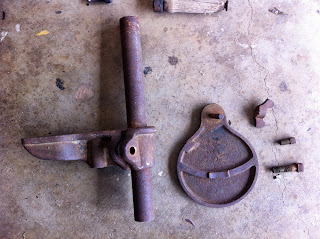What I also forgot to mention was the Dawn 611 is believed to have been a copy of the Buffalo Forge model 611. Us bloody convicts even stole the model number. The parts on my drill that are different to the versions of the 611 owned on mass actually closely resemble the Buffalo Forge Drill.
As you will see below the similarities are many.
My new acquisition is an old Silvers No# 1½
It is a more basic design but is far more difficult to operate. It basically requires three hands all at once.
One hand to drive the crank and one hand to manually feed the drill down, a third hand is needed to hold the work. Yes the work could be clamped to the table. However these were used to drill holes in the rims of wagon wheels which is what the Y shaped yolk is for, and the able is slid out of the way for this process.
THe Dawn on the other hand has an auto feed in the form of the ratchet mechanism and this must have been seem as a huge benefit.



















































